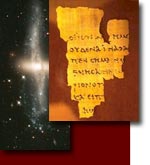| Site Map | Contacts | Links | Newsletter | |
Old Testament:
New Testament Quotation
Another important source is the New Testament (NT) when it quotes the OT. Most quotes are from the LXX which was the Bible of the NT church. From Alexander the Great onward Classical Greek became the most important language. At the time of the NT an easier "Koine" Greek was spoken which the NT is written. Before other ancient Greek manuscripts were discovered, it was thought that the NT was written in a special Holy Ghost language. The gospel of Matthew was most likely originally written in Aramaic then translated back into Greek. This would explain the similarities and differences it has with the other gospels. See web site New Testament Greek for resources.
There are about 5,000 Greek manuscripts which contain part or all of the NT. There are three different kinds of manuscripts: (1) papyri, (2) uncials (written in large capital Greek letters), and (3) minuscules (written in small Greek letters). There are also three different text types: (1) Western, (2) Caesarean, and (3) Byzantine.
The two most important collections of papyri were obtained by Mr. Chester Beatty of London in 1930-31 and by Mr. Martin Bodmer of Geneva in 1955-56. The oldest know papyrus fragment of the NT is p52 which contains John 18:31-33, 37-38. It was obtained by Bernard Grenfell in Egypt around 1920. It was discovered by C.H. Roberts in 1934 among other papyri in the John Rylands Library at Manchester (Metzger 1964, 38).
The two most important uncials are A and B. A is also know as codex Sinaiticus since it was discovered at the monastery of St. Catharine on Mount Sinai by Dr. Constantin von Tischendorf in 1844. B is also called codex Vaticanus because it is housed in the great Vatican Library at Rome. Both date to about the 4th century AD. Another important discovery were Greek papyri at Oxyrhynchus, Egypt.
